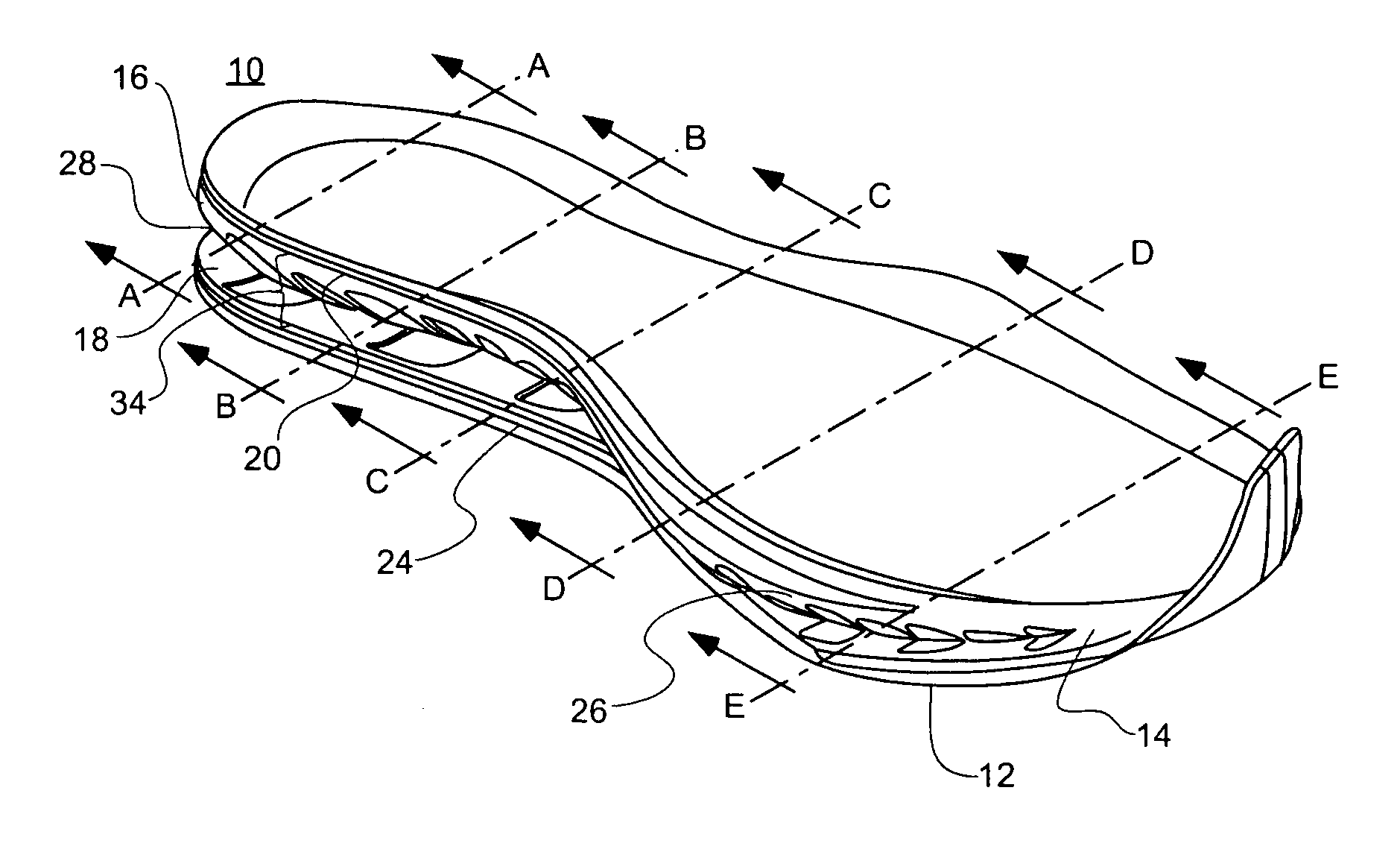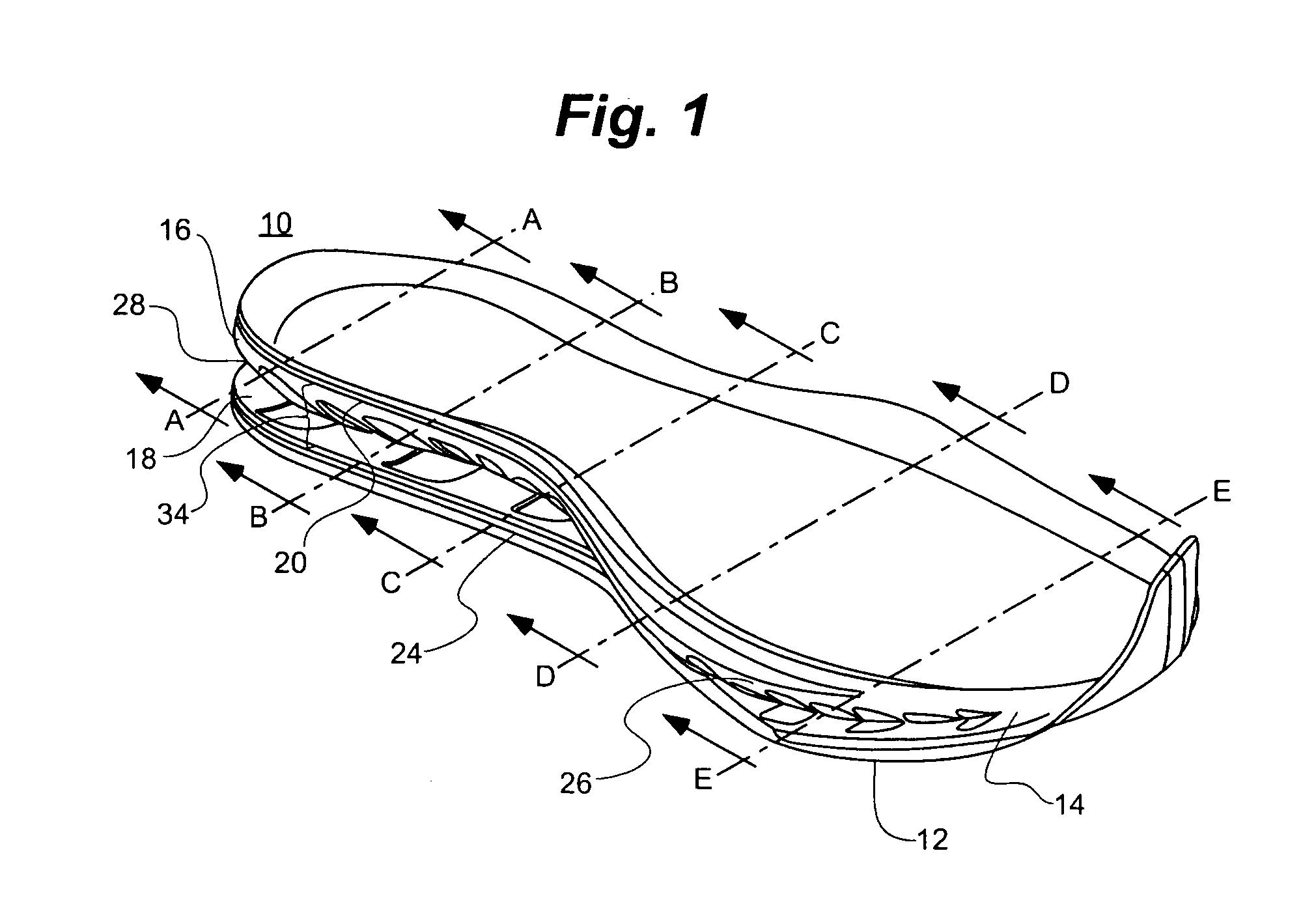Shoe sole for increasing instability
- Summary
- Abstract
- Description
- Claims
- Application Information
AI Technical Summary
Benefits of technology
Problems solved by technology
Method used
Image
Examples
embodiment 162
[0098]Because of the discrete nature of the concavely curved leaf springs 144 and convexly curved leaf springs 150, different areas of the shoe sole 10, for example (forefoot, rearfoot, midfoot), on different sides (medial and lateral) of the shoe sole 10 can be independently stiffened or softened to create any desired balance of cushioning, energy return, and stability. FIG. 9 shows an embodiment 162 of the structure that includes a central portion 164 in which the opposing concavely curved leaf springs 166 and convexly curved leaf springs 168 are of two different stiffnesses. The different stiffnesses may be provided by using different materials, different densities of a material, different thicknesses of a material, and so on. For example, the concavely curved leaf springs 166 may be made softer to provide additional cushioning and the convexly curved leaf springs 168 may be made harder to provide additional rebound. Additionally, the stiffness of the convexly curved leaf springs...
embodiment 170
[0099]Additionally, the length of the structure may be tuned to direct support from the leaf springs to various areas of the shoe sole. For example, FIG. 10A shows an embodiment 170 of the structure that includes a series of concavely 172 and convexly curved leaf springs 174 which extends from a heel to three-quarters the length of the shoe sole. Another embodiment, shown in FIG. 10B, includes a structure 176 that is adapted to extend from a rearfoot portion to a forefoot portion of a shoe sole of the present invention. In one embodiment, show in FIG. 10C, a structure 178 includes a series of concavely 180 and convexly 182 curved leaf springs adapted to extend from a heel to three-quarters the length of a shoe sole. The structure of FIG. 10C further includes upper 184 and lower extensions 186 that extend forward of the leaf springs 180, 182 into the forefoot portion of a shoe sole.
[0100]In another embodiment of the present invention, as shown in FIG. 11, a U-shaped structure 188 may...
embodiment 10
[0104]An embodiment of an outsole 208 with a curvature about a longitudinal axis 210 can be seen in FIGS. 13A, 13B, 13C, 13D and 13E, and FIGS. 14A, 14B, 14C, 14D and 14E, which show cross sections of the embodiment 10 of a shoe sole of FIG. 1 at lines A-A, B-B, C-C, D-D, and E-E, respectively. In this embodiment, the contact point 212 in the rearfoot portion of the outsole 208 is toward the medial side of the shoe sole 10, as shown in FIGS. 13A and 14A. The contact point 212 is shifted more towards the center of the shoe sole 10 in the cross section showing points further forward in the in shoe sole 10 in FIGS. 13B and 14B and 13C and 14C. The contact point 212 may be shifted towards the lateral side of the shoe sole 10 in the forefoot portion of the shoe sole 10 as shown in FIGS. 13D and 14D. In one embodiment, the curvature of the outsole 208 may shift toward the extreme lateral side of the shoe sole 10 in the toe area of the shoe sole 10, as shown in FIGS. 13E and 14E.
[0105]Addi...
PUM
 Login to View More
Login to View More Abstract
Description
Claims
Application Information
 Login to View More
Login to View More - R&D
- Intellectual Property
- Life Sciences
- Materials
- Tech Scout
- Unparalleled Data Quality
- Higher Quality Content
- 60% Fewer Hallucinations
Browse by: Latest US Patents, China's latest patents, Technical Efficacy Thesaurus, Application Domain, Technology Topic, Popular Technical Reports.
© 2025 PatSnap. All rights reserved.Legal|Privacy policy|Modern Slavery Act Transparency Statement|Sitemap|About US| Contact US: help@patsnap.com



